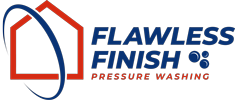Pressure Washing vs. Soft Washing: Which One is Right for Your Property?
When it comes to cleaning the exterior of your home or business, pressure washing and soft washing are two effective methods. While both techniques are designed to remove dirt, mold, algae, and grime, they differ significantly in terms of pressure, application, and best-use scenarios. In this blog, we’ll explore the key differences between pressure washing and soft washing to help you determine which method is best suited for your cleaning needs.
What is Pressure Washing?
Pressure washing, also known as power washing, utilizes high-pressure water to remove stubborn dirt, mold, and stains from hard surfaces. This method uses a motorized pump to generate a forceful spray, which is highly effective for cleaning surfaces such as:
- Concrete driveways and sidewalks
- Brick and stone patios
- Parking lots
The high-pressure water (typically between 1,500 and 4,000 PSI) makes pressure washing ideal for hard surfaces that can withstand intense force. However, if used on delicate materials, pressure washing can cause damage, stripping paint, etching concrete, or harming wood.
What is Soft Washing?
Soft washing is a gentler cleaning method that uses low-pressure water combined with specialized cleaning solutions to remove dirt, algae, mold, and mildew. This technique is particularly effective for more delicate surfaces such as:
- Roof shingles
- Vinyl siding
- Stucco and painted surfaces
- Wooden fences
The pressure in soft washing is significantly lower (typically under 500 PSI), reducing the risk of surface damage. The cleaning solutions used in soft washing break down organic growth and grime, allowing it to be rinsed away safely.
Key Differences Between Pressure Washing and Soft Washing
| Feature | Pressure Washing | Soft Washing |
|---|---|---|
| Pressure Level | 1,500 – 4,000 PSI | Under 500 PSI |
| Cleaning Method | High-pressure water | Low-pressure water with cleaning agents |
| Best for | Hard surfaces (concrete, brick, stone) | Delicate surfaces (roof, siding, stucco) |
| Risk of Damage | Higher if used incorrectly | Lower due to gentle pressure |
| Effectiveness | Removes deep-seated dirt and grime | Eliminates organic growth and stains |
Which Method Should You Choose?
The right cleaning method depends on the type of surface and the nature of the dirt or grime you want to remove:
- Choose pressure washing for hard, durable surfaces that can handle high-pressure cleaning.
- Choose soft washing for delicate materials or surfaces susceptible to damage from high pressure.
Final Thoughts
Both pressure washing and soft washing have their advantages, and choosing the right method ensures effective cleaning while preserving the integrity of your surfaces. If you’re unsure which technique to use, consider consulting a professional exterior cleaning service to assess your needs and recommend the best solution.
Do you need expert cleaning services for your home or business? Contact us today to schedule a professional pressure or soft washing service that will leave your property with a Flawless Finish!
